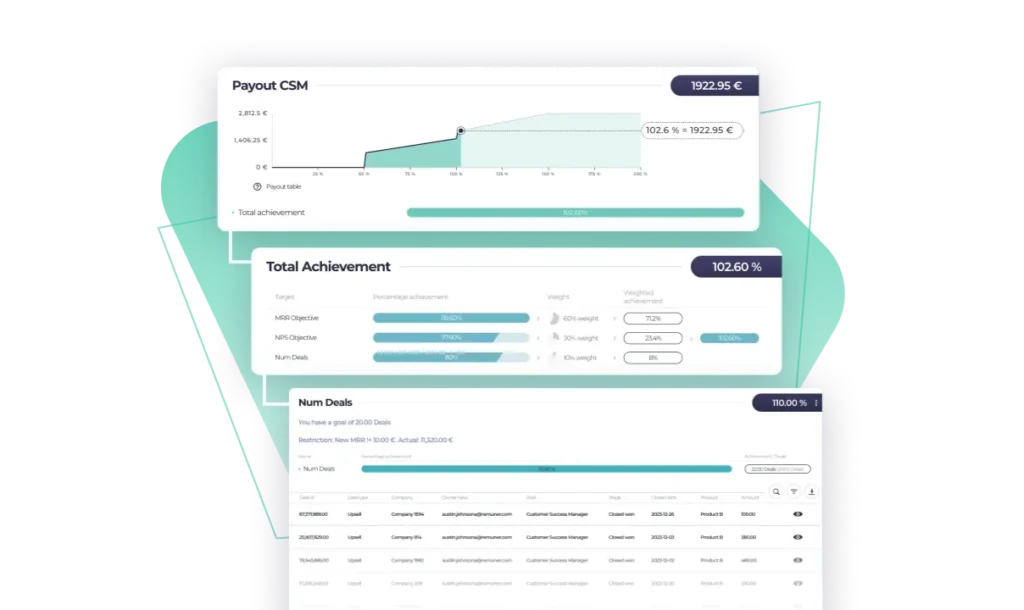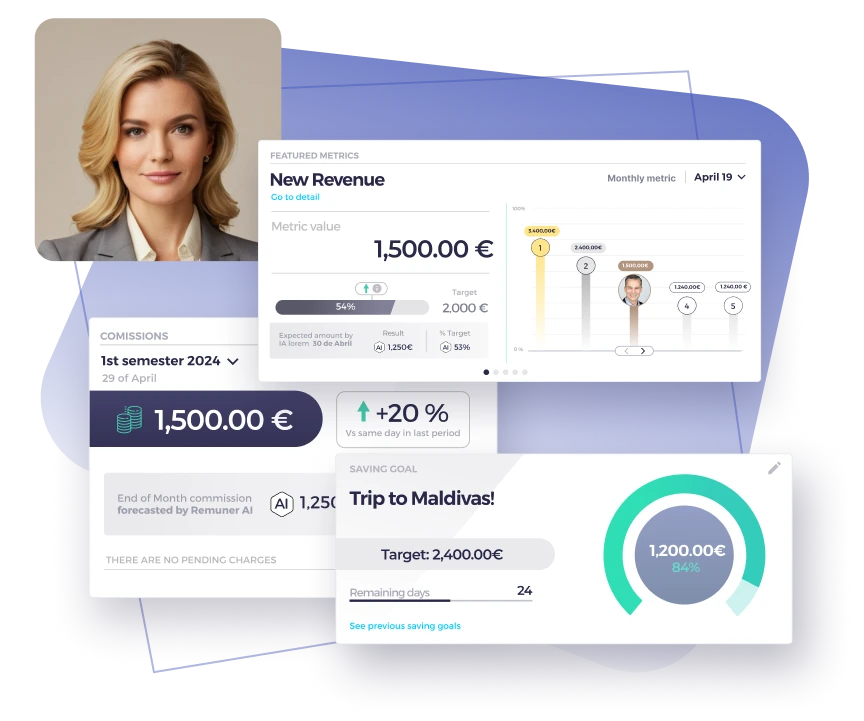Table of contents
In the fast-paced world of sales, where performance directly influences compensation, sales reports play a pivotal role. For sales professionals and leaders, having access to clear, real-time data is key to driving performance and maximizing incentives. A well-structured sales report provides visibility into sales activities, helping align sales compensation plans with overall performance goals. But what exactly is a sales report, and how does it tie into sales compensation?
What is a sales report?
A sales report is a detailed document or dashboard that provides insights into various metrics related to sales activities. These include revenue generated, deals closed, pipeline progress, and performance against sales quotas. Sales reports are used across teams—from sales representatives to leadership—providing them with actionable data that helps them hit targets, motivate teams, and improve performance.
When integrated into a sales dashboard, these reports become powerful tools for tracking performance, optimizing compensation plans, and driving sales incentives. Sales dashboards consolidate metrics from multiple sources, offering sales teams a holistic view of their progress in real time.
For instance, imagine a sales rep has a quota of $100,000 per month and earns a commission for every deal closed. Their sales dashboard shows that they’ve achieved 80% of their quota with two weeks remaining. This sales report not only provides an accurate overview of their performance but also serves as motivation to push harder and exceed their quota—unlocking higher sales incentives.
The connection between sales reports and compensation plans
Sales compensation plans are typically designed to reward top performers while driving overall productivity. However, without visibility into individual and team performance, achieving this alignment can be challenging. This is where sales reports become critical. They offer real-time insights into whether sales professionals are on track to meet their quotas and earn their OTE (on-target earnings), ensuring that compensation plans remain effective.
By consistently reviewing sales reports, sales leaders can identify high performers, adjust compensation plans as necessary, and drive better results. For example, if a sales report shows that a team is regularly hitting their quota but falling short in upselling or cross-selling, leaders can tailor sales incentives to encourage these behaviors.
7 steps to create a sales report
Creating a sales report that effectively tracks sales performance and aligns with your sales compensation goals requires careful planning and attention to detail. Here’s a step-by-step guide to help you design a comprehensive and actionable sales report:
1. Define your objectives
Start by clarifying what you want to achieve with your sales report. Are you focusing on tracking sales activities, monitoring progress toward quotas, or evaluating the effectiveness of sales incentives? Defining clear objectives will help you determine the right metrics to include in the report. For example, if your goal is to monitor how well your team is performing against their quotas, you should focus on metrics such as revenue generated, deals closed, and quota attainment.
2. Choose your data sources
A robust sales report draws data from multiple sources. These could include your sales reporting CRM, ERP, and other platforms that track sales activities and compensation plans. Ensure your systems are integrated to provide accurate, real-time data. For instance, if your sales report needs to track deal stages, you’ll want to pull data directly from your CRM, where sales reps update their deal progress. Similarly, if you need to monitor sales incentives or compensation payouts, integrating your compensation management platform is essential.
3. Select the right metrics
The next step is to choose the right metrics that align with your sales objectives and compensation structure. Common metrics include sales revenue, number of deals closed, average deal size, pipeline value, win rates, and time to close. Additionally, tracking metrics related to quotas, OTE, and sales incentives ensures that your sales report is relevant for evaluating compensation plans. For example, if a sales rep is underperforming against their quota, including metrics like deal value and lost opportunities can offer insights into why they are falling short.
4.Design a clear layout
A good sales report should present data in a clear, easy-to-digest format. Consider using a sales dashboard to visualize key metrics and trends. Charts, graphs, and tables can make complex data more accessible and actionable. For instance, a bar graph showing progress toward quotas can provide immediate visual feedback on whether a sales rep is on track. Meanwhile, a pie chart breaking down sales incentives earned versus potential earnings can highlight how performance directly impacts compensation.
5. Automate data collection:
One of the biggest challenges with sales reporting is ensuring that data is accurate and up to date. Automating data collection through integrations with CRMs, compensation platforms, and other sales tools minimizes errors. It also reduces the manual work required to create reports. Automation ensures that your sales report reflects the most recent data on sales performance. This enables real-time tracking of quotas, OTE, and sales incentives.
6. Customize reports for your audience
Different stakeholders will need different insights from a sales report. While sales reps may focus on their progress toward quotas and sales incentives, sales leaders might need a broader view of team performance and pipeline health. Finance teams may require a breakdown of compensation payouts and ROI. Tailor your report layout and metrics to meet the specific needs of each audience. For example, a report for sales reps might highlight individual deals and quota attainment, while a report for finance might include detailed compensation data and metrics on sales incentives.
7. Review and refine regularly
Once your sales report is up and running, it’s important to review it regularly. This ensures it continues to meet your needs. As your compensation plans and sales strategies evolve, you may need to adjust the metrics you track or how the data is presented. Regularly updating your sales reporting CRM and dashboards helps ensure your reports stay aligned with your sales objectives and compensation structures.
By following these steps, you can create a sales report that not only tracks sales activity but also aligns with your compensation plans, helping to drive better sales performance and increase transparency across your sales organization.

Sales reports in CRM systems
Today’s businesses rely on advanced CRM platforms for tracking customer interactions, pipeline data, and sales metrics. When integrated with CRM, sales reporting becomes a dynamic, real-time tool that enhances transparency and accountability. Sales reps can easily access detailed reports within their sales reporting CRM, ensuring that they remain aligned with their sales performance objectives.
For example, a CRM-based sales report can highlight that a particular deal is stuck in the negotiation stage. With this information, the sales rep can focus their efforts on closing that deal to meet their quota. The impact on their sales incentives is immediate and measurable, as closing deals drives compensation.
Key KPIs to include in your sales report
When creating a sales report, selecting the right KPIs (Key Performance Indicators) is crucial to ensure it provides meaningful insights that drive action. These KPIs should align with your sales compensation structure and performance goals. Here are the key KPIs to consider:
- Sales Revenue: This is the total amount of income generated from closed deals within a specific period. It is a fundamental metric that ties directly to performance and compensation.
- Deals Closed: The number of deals successfully closed during the reporting period. This KPI provides insight into a sales rep’s ability to convert opportunities into revenue.
- Pipeline Value: This KPI shows the total value of active deals in the sales pipeline. It helps forecast future revenue and evaluate the overall health of the pipeline.
- Quota Attainment: Tracking how close each sales rep is to meeting their sales quota is critical for evaluating performance against expectations and calculating OTE.
- Average Deal Size: The average value of closed deals. This metric helps assess whether sales reps are focusing on high-value opportunities or lower-ticket deals.
- Win Rate: This KPI measures the percentage of deals won versus total deals pursued. It’s a strong indicator of a rep’s efficiency and effectiveness in closing deals.
- Time to Close: This metric tracks the average length of time it takes to close a deal from initial contact to final agreement. A shorter time to close indicates a more efficient sales process.
- Sales Cycle Length: Similar to time to close, this KPI provides insights into how long it typically takes for deals to move through the entire sales funnel, from lead to deal.
- Sales Incentives Earned: Monitor the total amount of sales incentives earned by each rep. This KPI helps track how compensation is aligning with sales performance and motivation.
- Customer Acquisition Cost (CAC): This KPI calculates how much it costs to acquire a new customer. Understanding this helps assess whether sales efforts are cost-effective.
- Upsell and Cross-sell Rates: These KPIs measure how often reps are successfully selling additional products or services to existing customers, an important driver for increasing revenue.
Including these KPIs in your sales report will provide a comprehensive view of both individual and team sales performance, helping leaders make data-driven decisions that enhance compensation plans, improve motivation, and drive revenue growth.

Aligning quotas, OTE, and sales incentives with reporting
Setting quotas is one thing—ensuring that these quotas are being met is quite another. A solid sales report is the bridge between expectations and results. With transparent sales reporting, sales teams have full visibility into their progress toward achieving their quotas and OTE. This transparency ensures alignment between effort and reward.
For instance, let’s say a sales manager reviews a sales report showing that 70% of the team has already achieved their quota for the quarter. The manager might introduce a new sales incentive for the remaining weeks, such as additional bonuses for deals closed above quota. This data-driven approach encourages the team to push for greater success, directly impacting their sales compensation.
Using sales reports to drive performance improvement
Sales leaders are constantly looking for ways to improve sales performance. Sales reports provide the necessary data to evaluate both individual and team performance, enabling managers to identify areas for improvement. Whether it’s providing additional coaching, adjusting quotas, or introducing new sales incentives, sales reports offer the insights needed to make informed decisions.
For example, if a sales report reveals that a specific team member is consistently underperforming compared to their peers, leadership can investigate potential reasons—such as training gaps or unrealistic quotas—and provide the necessary support. This proactive approach not only boosts individual sales performance but also ensures that compensation plans are fair and effective.
Maximizing sales performance with your sales report
A well-structured sales report is an essential tool for any sales team looking to align performance with compensation. It offers transparency, drives accountability, and motivates sales professionals, sales reporting. This helps teams stay focused on hitting their quotas, earning their OTE, and achieving top performance.
Sales dashboards and sales reporting CRMs make this process even easier. They offer real-time insights that empower sales professionals to stay motivated and continuously improve their sales performance. Ultimately, the right sales report not only tracks performance but also drives meaningful, data-driven changes. These changes can take sales teams to the next level.
How Remuner can help optimize your sales compensation with sales reports
When it comes to managing sales compensation, Remuner offers a powerful solution. It integrates seamlessly with your sales reports and dashboards to provide real-time insights into sales performance. By automating your sales compensation process, Remuner ensures that your teams have full visibility into their quotas, on-target earnings, and sales incentives. This transparency drives both motivation and accountability.
Remuner connects directly to your CRM and other systems, ensuring that your sales reports reflect the most accurate data. Sales reps can easily track their progress toward their goals, while leaders can monitor overall team performance. The platform’s no-code compensation designer allows you to model and adjust any compensation plan quickly and effectively, ensuring that your sales reports always align with your current objectives.
With Remuner, you can also access AI-driven insights that help optimize your compensation plans based on data from your sales reports. This enables you to create plans that not only motivate your team but also align perfectly with your revenue goals. In short, Remuner makes it easier to connect sales performance to compensation, helping you drive better results and make more informed, data-driven decisions.





